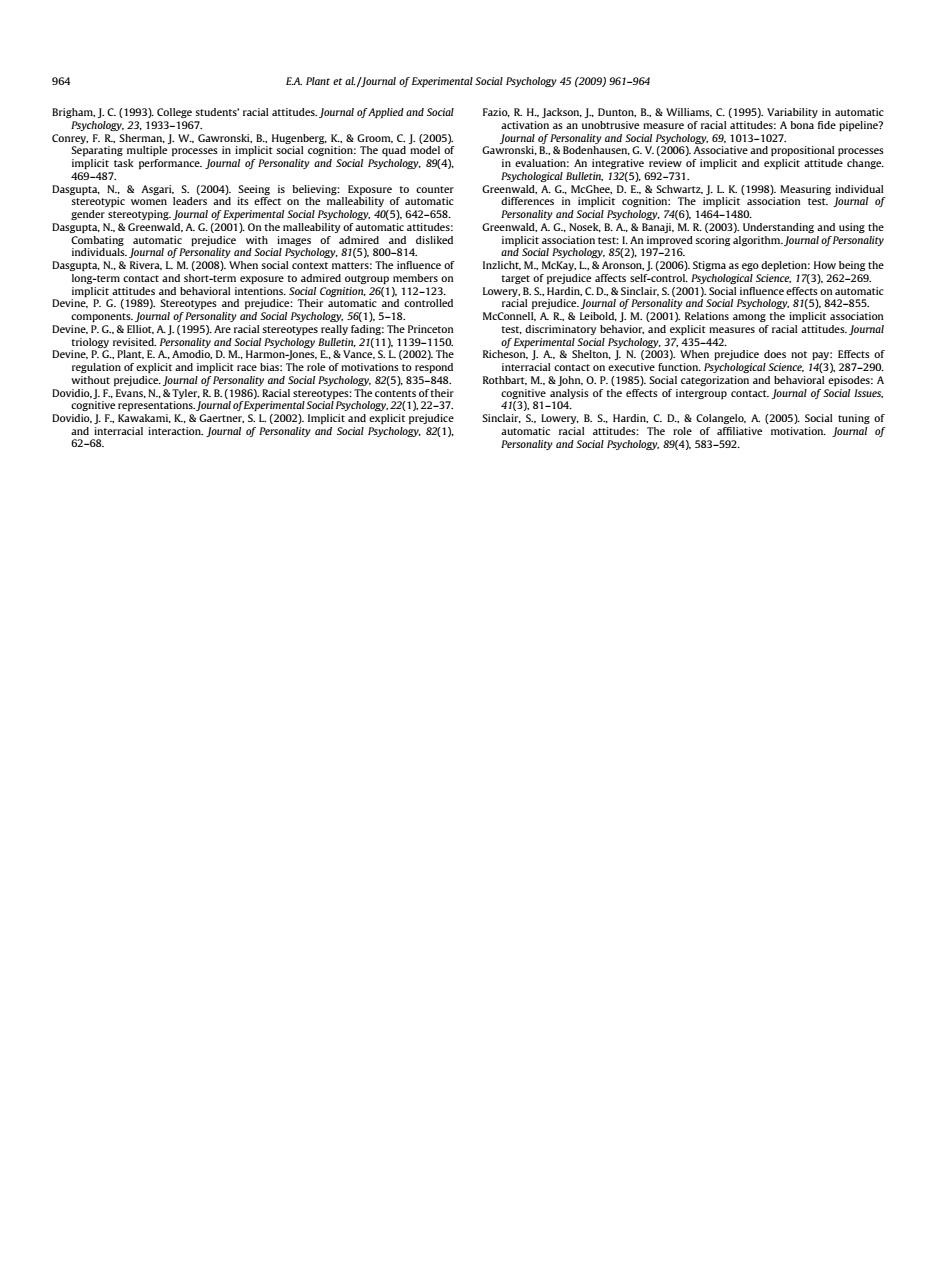正在加载图片...

96 upta.N 长 N&O AC.20011 d disliked M. pes and p preudic Their autom 26()112-12cd 875842-855. 211 N.(20 Brigham, J. C. (1993). College students’ racial attitudes. Journal of Applied and Social Psychology, 23, 1933–1967. Conrey, F. R., Sherman, J. W., Gawronski, B., Hugenberg, K., & Groom, C. J. (2005). Separating multiple processes in implicit social cognition: The quad model of implicit task performance. Journal of Personality and Social Psychology, 89(4), 469–487. Dasgupta, N., & Asgari, S. (2004). Seeing is believing: Exposure to counter stereotypic women leaders and its effect on the malleability of automatic gender stereotyping. Journal of Experimental Social Psychology, 40(5), 642–658. Dasgupta, N., & Greenwald, A. G. (2001). On the malleability of automatic attitudes: Combating automatic prejudice with images of admired and disliked individuals. Journal of Personality and Social Psychology, 81(5), 800–814. Dasgupta, N., & Rivera, L. M. (2008). When social context matters: The influence of long-term contact and short-term exposure to admired outgroup members on implicit attitudes and behavioral intentions. Social Cognition, 26(1), 112–123. Devine, P. G. (1989). Stereotypes and prejudice: Their automatic and controlled components. Journal of Personality and Social Psychology, 56(1), 5–18. Devine, P. G., & Elliot, A. J. (1995). Are racial stereotypes really fading: The Princeton triology revisited. Personality and Social Psychology Bulletin, 21(11), 1139–1150. Devine, P. G., Plant, E. A., Amodio, D. M., Harmon-Jones, E., & Vance, S. L. (2002). The regulation of explicit and implicit race bias: The role of motivations to respond without prejudice. Journal of Personality and Social Psychology, 82(5), 835–848. Dovidio, J. F., Evans, N., & Tyler, R. B. (1986). Racial stereotypes: The contents of their cognitive representations. Journal of Experimental Social Psychology, 22(1), 22–37. Dovidio, J. F., Kawakami, K., & Gaertner, S. L. (2002). Implicit and explicit prejudice and interracial interaction. Journal of Personality and Social Psychology, 82(1), 62–68. Fazio, R. H., Jackson, J., Dunton, B., & Williams, C. (1995). Variability in automatic activation as an unobtrusive measure of racial attitudes: A bona fide pipeline? Journal of Personality and Social Psychology, 69, 1013–1027. Gawronski, B., & Bodenhausen, G. V. (2006). Associative and propositional processes in evaluation: An integrative review of implicit and explicit attitude change. Psychological Bulletin, 132(5), 692–731. Greenwald, A. G., McGhee, D. E., & Schwartz, J. L. K. (1998). Measuring individual differences in implicit cognition: The implicit association test. Journal of Personality and Social Psychology, 74(6), 1464–1480. Greenwald, A. G., Nosek, B. A., & Banaji, M. R. (2003). Understanding and using the implicit association test: I. An improved scoring algorithm. Journal of Personality and Social Psychology, 85(2), 197–216. Inzlicht, M., McKay, L., & Aronson, J. (2006). Stigma as ego depletion: How being the target of prejudice affects self-control. Psychological Science, 17(3), 262–269. Lowery, B. S., Hardin, C. D., & Sinclair, S. (2001). Social influence effects on automatic racial prejudice. Journal of Personality and Social Psychology, 81(5), 842–855. McConnell, A. R., & Leibold, J. M. (2001). Relations among the implicit association test, discriminatory behavior, and explicit measures of racial attitudes. Journal of Experimental Social Psychology, 37, 435–442. Richeson, J. A., & Shelton, J. N. (2003). When prejudice does not pay: Effects of interracial contact on executive function. Psychological Science, 14(3), 287–290. Rothbart, M., & John, O. P. (1985). Social categorization and behavioral episodes: A cognitive analysis of the effects of intergroup contact. Journal of Social Issues, 41(3), 81–104. Sinclair, S., Lowery, B. S., Hardin, C. D., & Colangelo, A. (2005). Social tuning of automatic racial attitudes: The role of affiliative motivation. Journal of Personality and Social Psychology, 89(4), 583–592. 964 E.A. Plant et al. / Journal of Experimental Social Psychology 45 (2009) 961–964